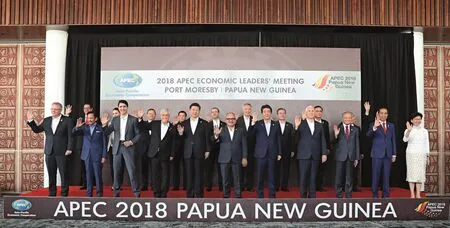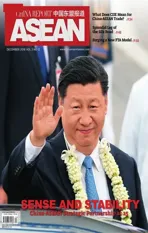BUILDING AN OPEN ECONOMY IN THE ASIA-PACIFIC
2018-12-25ByWangFang
By Wang Fang
Port Moresby, Papua New Guinea, welcomed guests from around the world for the 26th Asia-Pacific Economic Cooperation (APEC) Economic Leaders’Meeting in mid-November. For thefirst time,leaders, business representatives and members of academic circles of the 21 APEC members gathered in the Pacific island country to discuss boosting prosperity in the Asia-Pacific region.
Sustainable and inclusive growth, regional economic integration and connectivity were among the key words of the meeting, charting the future for regional cooperation.On November 18, Chinese President Xi Jinping delivered a speech titled “Harnessing Opportunities of Our Times to Jointly Pursue Prosperity in the Asia-Pacific” to share Chinese wisdom on Asia-Pacific development and cooperation with attendees of the meeting.
Chinese Solutions for Asia-Pacific Development
Amid risk and uncertainty in the world economy, the prospects of the Asia-Pacific region have become an issue attracting widespread attention.

Chinese President Xi Jinping (front row,fifth left) and other leaders and representatives from APEC members pose for a group photo before the 26th APEC Economic Leaders’ Meeting in Port Moresby, Papua New Guinea, on November 18.

“As the main engine driving the global economy, the Asia-Pacific region is tremendously significant,” declared Sun Jingxin, assistant research fellow with the Academy of Contemporary China and World Studies. “The Asia-Pacific economy accounts for around 60 percent of the world total,and regional trade takes up 48 percent. China’s economy is particularly impressive.”
Since its inclusion in the APEC in 1991, China has been actively involved in regional cooperation as it injects robust vitality into regional economic development through Chinese wisdom. Over recent years, China’s contribution to global economic growth has remained over 30 percent. It is also the major trading partner and source of foreign direct investment for countries in the Asia-Pacific region.
Currently facing a complicated economic situation,Chinese President Xi Jinping once again offered China’s solution to various challenges while addressing the APEC CEO Summit on November 17.
He called on economies around the world to focus on openness to create more space for development, on development that delivers more benefits to the people, on inclusiveness and interaction, on innovation to tap new sources of growth, and on a rules-based approach to improve global governance.
Undeniably, Asia-Pacific countries vary in culture,national conditions and development paths, and each country has unique demands. In response, Xi proposed,“We need to respect diversity and each other’s choice of development path, promote integration and mutual learning on the basis of openness and inclusiveness,and engage in both healthy competition and mutually beneficial cooperation. Through such efforts, we can jointly build a community with a shared future in the Asia-Pacific.”
“Chinese President Xi Jinping reviewed the challenges the international community faces and offered China’s solution and wisdom to promote economic development and cooperation in the Asia-Pacific region and the rest of the world,” Chinese Foreign Minister Wang Yi told media.
“Chinese President Xi Jinping’s speech communicated China’s confidence and strengths to the world and boosted confidence in China among developing economies in the Asia-Pacific region,” commented director of the Indonesiabased think tank Asia Innovation Research Center. “I believe China’s circle of friends will further expand and become cemented.”
An expert on Chinese issues with the Ateneo de Manila University noted that China has been sharing experience and jointly working with other countries in the region to address challenges with an open and inclusive attitude, showing ideal behavior of a responsible power.

Widely-Recognized Inclusive Approach
APEC has facilitated cooperation for nearly 30 years. It has remained dedicated to trade and investment liberalism,sustainable and inclusive development and regional economic integration. APEC countries have maintained shared aspirations to foster partnerships featuring mutual trust, inclusiveness and win-win cooperation.
The theme of this year’s APEC is Harnessing Inclusive Opportunities, Embracing the Digital Future. Against the backdrop of rampant protectionism and unilateralism,China’s steadfast commitment to free trade has been particularly prominent. At APEC meetings, President Xi reiterated China’s stance to support free and open trade and to voluntarily open its market to the world.
Kin Phea, director general of the International Relations Institute of the Royal Academy of Cambodia, said China’s commitment to openness impressed him and that an open China would inject potent momentum into regional economic integration.
Oh Ei Sun, principal advisor at the Pacific Research Center in Malaysia, commented that trade liberalization and new technologies are two major engines driving the sustainable growth of the world economy. China’s achievements in these twofields are evident, especially as evidenced by the recent China International Import Expo. He was confident that China will play an even greater contributing role in these twofields.
“The digital economy, with tremendous momentum and potential, is emerging as the backbone of the world economy,” opined Sun Jingxin, adding that countries in the Asia-Pacific region had reached wide consensus on tapping the potentials of the digital economy and riding the wave of the boom. Statistics show that China’s digital economy was valued at 27.2 trillion yuan (US$3.91 trillion) in 2017,accounting for 32.9 percent of its GDP and ranking second in the world.
Xi said China is ready to make greater contribution to world prosperity while it develops. Jointly building the Belt and Road Initiative is a way for China to share development opportunities and pursue common prosperity with the rest of the world.
“Connectivity is crucial to Brunei, and the Belt and Road Initiative proposed by China is of great significance,” said a Deputy Minister of Industry and Primary Resources of Brunei. “Only through win-win cooperation can we build unique competitiveness.”
Participants of the meetings unanimously agreed that an open Asia-Pacific economy and inclusive growth are conducive to regional economic integration and the growth of world economy as well as building a fairer international trade order and more open world economy.
